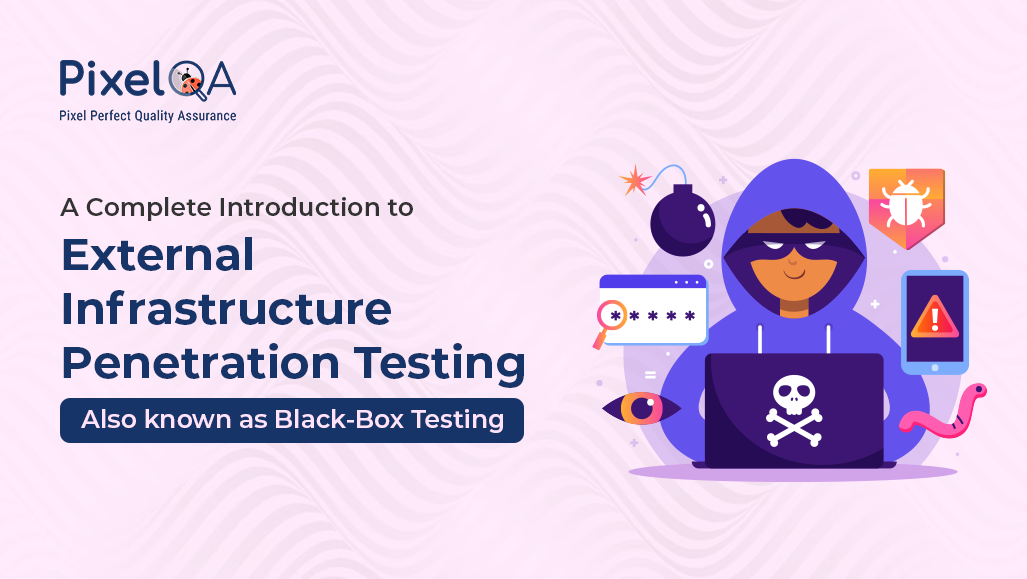
Organizations are getting more at risk from hackers who take advantage of loopholes in their external infrastructure in today's highly connected digital environment. Identification and remediation of such vulnerabilities prior to attackers are enabled through external infrastructure penetration testing, specifically via black‑box testing. With emphasis on black‑box testing, its importance, process, and how penetration testing services help business enterprises improve their security position, this article provides a comprehensive overview of external infrastructure penetration testing services.
Table of Contents
- An explanation of penetration testing's "black box" testing
- Why is External Infrastructure Penetration Testing Important?
- Key Components of External Infrastructure Penetration Testing
- Explain the Importance of Penetration Testing Services
- Tools Used in External Infrastructure Penetration Testing
- Challenges in External Infrastructure Penetration Testing
- How to Prepare for External Infrastructure Penetration Testing
- Real‑World Example: A Black‑Box External Penetration Test
- Conclusion
An Explanation of Penetration Testing's "Black Box" Testing
Three types of penetration testing may be distinguished based on the tester's degree of target knowledge:
- White‑Box Testing: Testers have complete knowledge of the system, including its architecture, source code, and login credentials.
- Gray‑Box Testing: Testers only have moderate information about the system.
- Black‑Box Testing: Testers test like an outside hacker without any prior knowledge regarding the system they perform penetration testing on.
Black‑box testing uses testers who have no inside knowledge and only depend on publicly known information, scanning, and their expertise to locate vulnerabilities. It is the best simulation of actual external attacks and thus forms the critical methodology to evaluate an organization's external security.
Why is External Infrastructure Penetration Testing Important?
- Shield Against Cyberattacks: Attackers are regularly attempting attacks on external infrastructure to gain access or extract data.
- Regulatory Compliance: Many industries require penetration testing for compliance.
- Identify Configuration Errors: Helps find and fix misconfigurations and vulnerabilities.
- Test Incident Response: Evaluates how well organizations detect and respond to real threats.
- Prevent Financial Loss: Avoids costly breaches or outages that impact business continuity and reputation.
Key Components of External Infrastructure Penetration Testing
1. Reconnaissance (Information Gathering)
This phase involves gathering publicly available information about the target. Techniques include:
- DNS queries
- WHOIS lookups
- Network scanning
- Open‑source intelligence (OSINT)
2. Scanning and Enumeration
Testers scan for active hosts and services using tools like Nmap, Nessus, and OpenVAS to identify open ports and running services.
3. Vulnerability Assessment
Automated scanners and databases are used to identify known vulnerabilities and rank them by severity.
4. Exploitation
This involves attempting to exploit the identified vulnerabilities using techniques such as SQL injection, buffer overflows, or exploiting misconfigured services.
5. Post‑Exploitation
After gaining access, testers analyze privilege escalation, data exfiltration, and persistence mechanisms to understand the depth of potential compromise.
6. Reporting and Recommendations
Detailed reports highlight:
- Identified vulnerabilities
- Attack methods
- Impact assessment
- Remediation strategies
Explain the Importance of Penetration Testing Services
Most companies lack the resources or expertise to conduct in‑depth penetration testing internally. That’s where professional penetration testing services come in.
Benefits of Penetration Testing Services
- Expertise: Access to skilled professionals with knowledge of current threats.
- Objectivity: Third‑party testers offer unbiased evaluation.
- Comprehensive Testing: Combine manual and automated methods for accurate results.
- Compliance: Ensures adherence to regulatory standards.
- Customized Approach: Tailored testing based on industry and infrastructure.
Tools Used in External Infrastructure Penetration Testing
- Nmap: Port and network scanner
- Nessus/OpenVAS: Vulnerability scanners
- Metasploit: Exploitation framework
- Nikto: Web server vulnerability scanner
- Burp Suite: Web application penetration testing
- Recon‑ng: OSINT tool
Challenges in External Infrastructure Penetration Testing
- Scope Definition: Deciding what assets to test
- False Positives/Negatives: Scanner inaccuracies
- Time Constraints: Limited testing windows
- Constant Change: Infrastructure updates may invalidate test results
- Legal Considerations: Testing requires formal authorization
How to Prepare for External Infrastructure Penetration Testing
- Define clear scope and goals
- Inform key stakeholders
- Backup essential data
- Ensure legal testing approval
- Review previous assessments and security documentation
Real‑World Example: A Black‑Box External Penetration Test
A financial firm hires a penetration testing company to conduct a black‑box test. The testers identify an outdated web server via a port scan. Exploiting known vulnerabilities, they gain unauthorized access and move laterally to internal databases. Their report highlights issues like weak firewall rules and outdated patches. The company fixes these flaws, improving segmentation and applying updates — significantly enhancing security.
Conclusion
Any business trying to defend itself against external cyber threats must do external infrastructure penetration testing, particularly black‑box testing. Black‑box testing exposes flaws that could otherwise be overlooked by simulating the viewpoint of an outside attacker.
Using professional penetration testing services guarantees unbiased and current requirements that comply with regulatory standards. These services give businesses the information they need to strengthen defenses and stop expensive breaches by thorough scanning, exploitation, and detailed reporting.
About Author

Rushi Mistry is a Security Analyst at PixelQA with a focus on cybersecurity. He is passionate about IoT penetration testing and is working towards obtaining a CISSP certification, with the ultimate goal of becoming a Chief Information Security Officer (CISO).

